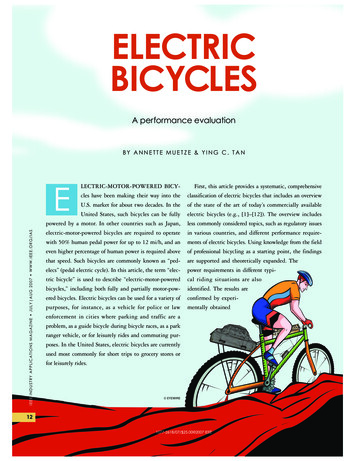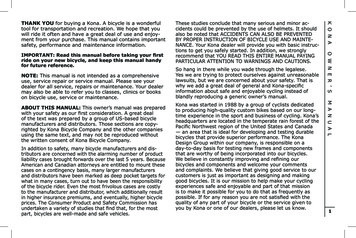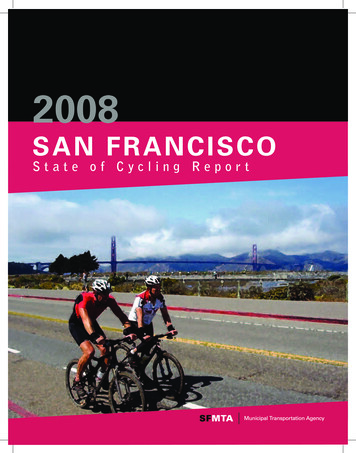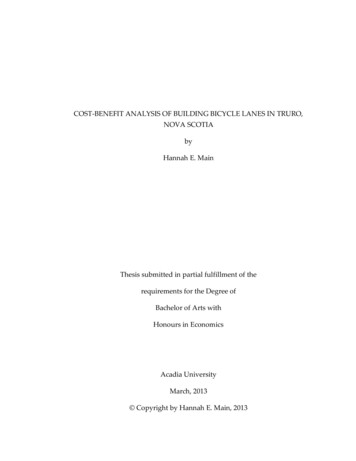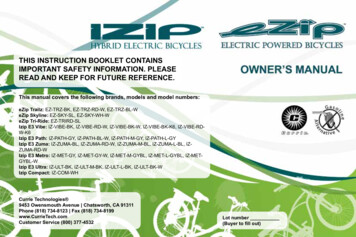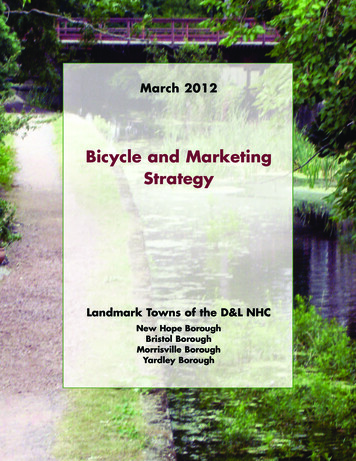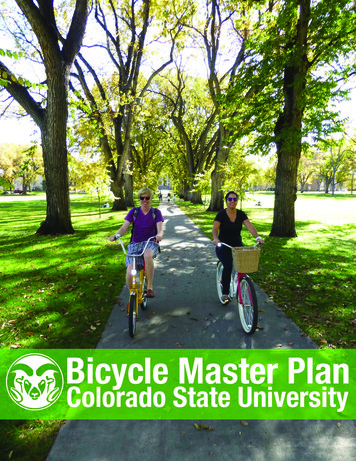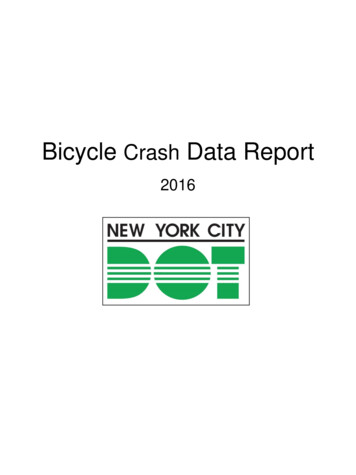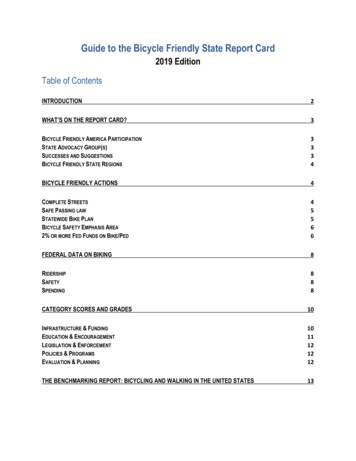
Transcription
Guide to the Bicycle Friendly State Report Card2019 EditionTable of ContentsINTRODUCTION2WHAT’S ON THE REPORT CARD?3BICYCLE FRIENDLY AMERICA PARTICIPATIONSTATE ADVOCACY GROUP(S)SUCCESSES AND SUGGESTIONSBICYCLE FRIENDLY STATE REGIONS3334BICYCLE FRIENDLY ACTIONS4COMPLETE STREETSSAFE PASSING LAWSTATEWIDE BIKE PLANBICYCLE SAFETY EMPHASIS AREA2% OR MORE FED FUNDS ON BIKE/PED45566FEDERAL DATA ON BIKING8RIDERSHIPSAFETYSPENDING888CATEGORY SCORES AND GRADES10INFRASTRUCTURE & FUNDINGEDUCATION & ENCOURAGEMENTLEGISLATION & ENFORCEMENTPOLICIES & PROGRAMSEVALUATION & PLANNING1011121212THE BENCHMARKING REPORT: BICYCLING AND WALKING IN THE UNITED STATES13
Guide to the Bicycle Friendly State Report Card 2019IntroductionThe Bicycle Friendly State Report Card is intended to provide highlighted information about each state to provide auseful comparison between states and serve as a reference for state efforts related to bicycling.This guide will provide background information on each of the data points on the Report Card. It is our hope that thisbackground will answer questions about where this data comes from and how it should be interpreted.It is important to note that the data on the Report Card do not necessarily reflect the totality of a state’sefforts related to bicycling. The Report Card also does not explicitly consider factors such as natural beauty,weather, or culture that may affect riding in a state. While the majority of data relate to actions by a state Departmentof Transportation, the data is not limited to things within the control or influence of a state Department ofTransportation. Many states have efforts that do not fit within the survey and public data used to create the ReportCard.Explanation of RankingThe ranking for each state is based upon a weighted score based upon the state’s score in each of the fivecategories listed on the Report Card. The weighted category scores are supplemented by discretionary scoring thataccounts for 10% of each state’s potential score. We include discretionary scoring to account for erroneous surveydata, states with missing data, and other factors that do not easily fit within the survey data and public data used forthe category scores.-Infrastructure & Funding – 20%Education & Encouragement – 15%Legislation & Enforcement – 15%Policies & Programs – 20%Evaluation & Planning – 20%Discretionary Scoring – 10%History of RankingThe Bicycle Friendly State program began in 2008. The primary output of the Bicycle Friendly State program sincethat time has been an annual ranking of each state according to publicly available data and survey data completed bycontacts at state Departments of Transportation or state advocacy organizations. Data on rankings over time isavailable at al ranking chart.pdf. Report cards were introduced to theprogram in 2012 and are available upon request.The best way to explore data from the history of the program is by using the data produced in Bicycling and Walkingin the United States: A Benchmarking Report. This report has been published since 2007 and has shared a commonsurvey with the Bicycle Friendly State program since 2012. Over six editions it has published the raw data that isanalyzed to create our Bicycle Friendly State ranking without the editorial weighting used to create the ranking. Themost recent Benchmarking Report can be explored at https://bikeleague.org/benchmarking-report.2
Guide to the Bicycle Friendly State Report Card 2019What’s on the Report Card?Bicycle Friendly America ParticipationEach Report Card includes data on the participation by communities, businesses, and universities within each statein other Bicycle Friendly America (BFA) programs. The Bicycle Friendly State program is the only non-voluntary BFAprogram. All other BFA program participation depends upon participants to complete an application. Bicycle Friendly Community – The Bicycle Friendly Community program is based upon a free applicationthat is available to all communities. Since the creation of the Bicycle Friendly Community program in 1995there have been over 1500 community applications processed by League staff. As of spring 2019, therewere 475 recognized Bicycle Friendly Communities and over 100 Honorable Mention communities in all 50states. Bicycle Friendly Business – The Bicycle Friendly Business program is based upon a paid application that isavailable to all communities. The application fee is based upon the size of the organization:http://bikeleague.org/BFB Fee Deadline. There are more than 1,300 recognized Bicycle FriendlyBusinesses in all 50 states and the District of Columbia. Bicycle Friendly University – The Bicycle Friendly University program is based upon a free application that isavailable to all communities. The application fee for universities is a flat fee regardless of university size.There are a variety of discounts available for certain types of universities, including historically blackcolleges and universities, women’s colleges, and community colleges: university/BFUfee. There are more than 150 recognized Bicycle Friendly Universities in44 states and the District of Columbia.State Advocacy Group(s)The group(s) identified on the report card is any group that is an organizational member of the League of AmericanBicyclists and has been identified as a statewide advocacy organization. Member organizations of the League ofAmerican Bicyclists are: Eligible to participate in the League’s insurance program; Listed in the League’s Cycling in Your Area Guide; Eligible to have events listed in the League’s Cycling in Your Area Guide; Eligible for discounted registration for the National Bike Summit, held annually in Washington, D.C.; and Invited to participate in Bicycle Friendly America local review processes.Advocacy organizations identify themselves as state organizations. It is a membership type and the League did notreview mission statements or actions by our organizational members before listing them on the report card. They arelisted because they joined and/or renewed as a state advocacy organization.Successes and SuggestionsSuccesses and Suggestions are generated by each state’s answers to the Bicycle Friendly State survey as well asinput from state advocates as part of the local review process and discretionary decisions by League of AmericanBicyclists staff. Most Successes and Suggestions are generated from survey data and reflect areas where: A state has accomplished or updated a Bicycle Friendly Action; A state has taken a positive step toward a feedback point from a previous Bicycle Friendly State ReportCard; A state does not have a policy, program, or law that is highly valued by the Bicycle Friendly State ranking;3
Guide to the Bicycle Friendly State Report Card 2019 A state has a law or policy that is considered detrimental to bicycling by the League of American Bicyclists;orA state underperforms on an output metric based upon federal data.Most Feedback Points are not customized or minimally customized to reflect underlying state practices. The primarypurpose of each Feedback Point is to clearly identify an area for improvement and suggest a possible solution. Thesolution most suitable to any given state may be different than the solution suggested by a Feedback Point.Bicycle Friendly State RegionsAlthough not included in the 2019 Bicycle Friendly State Report Card, the four regions used in prior report cards areprovided below. States are listed in alphabetical order within their region.Eastern RegionSouthern RegionMidwestern RegionWestern eMarylandMassachusettsNew HampshireNew JerseyNew YorkPennsylvaniaRhode naMississippiNorth CarolinaSouth CarolinaTennesseeTexasVirginiaWest NebraskaNorth DakotaOhioOklahomaSouth oMontanaNevadaNew MexicoOregonUtahWashingtonWyomingBicycle Friendly ActionsEach Bicycle Friendly State Report Card includes five Bicycle Friendly Actions (Actions). These Actions reflect inputmetrics that are entirely within the control of a state’s Department of Transportation, legislature, or other stateagency. They are labeled as “Bicycle Friendly Actions” because the League believes that these metrics are evidenceof successful agency, legislative, or advocacy actions that set the stage for improvements in the safety and mobilityof people who bike within a state. In prior versions of the Bicycle Friendly State program these Actions were referredto as “Signs of Success.”On the Report Card, blue and orange checkmarks identify Bicycle Friendly Actions for each state. Blue checkmarksidentify an Action that a state has had in the past. Orange checkmarks identify states where “New Progress in 2019”has occurred, this includes any changes and updates to an existing Action that has occurred since 2017.Each of the Bicycle Friendly Actions, and the way in which we determine whether a state has taken an Action, isexplained below.Complete StreetsComplete Streets, according to the National Complete Streets Coalition, are “are streets for everyone. They aredesigned and operated to enable safe access for all users, including pedestrians, bicyclists, motorists and transit4
Guide to the Bicycle Friendly State Report Card 2019riders of all ages and abilities . By adopting a Complete Streets policy, communities direct their transportationplanners and engineers to routinely design and operate the entire right of way to enable safe access for allusers, regardless of age, ability, or mode of transportation.”For our Bicycle Friendly State Report Cards, the League uses data from the National Complete Streets Coalition’sInventory of all Complete Streets policies to determine whether a state receives the Complete Streets Law/PolicyBicycle Friendly Action. That Inventory identifies at least three ways in which states can adopt Complete Streets –through a resolution, policy, or law. In our scoring of the Complete Streets topic we differentiate between thesemethods, but for the Bicycle Friendly Action any method results in a checkmark.In 2018, the League published a white paper to help states interested in taking this Bicycle Friendly Action.Safe Passing lawSafe passing laws require vehicles to pass each other at a safe distance. In most states, legislatures haverecognized that "safe distance" requires further definition, particularly for motor vehicles passing people on bicycles.The Safe Passing Law Bicycle Friendly Action recognizes states that have adopted a law that specifically defines asafe distance for a motor vehicle passing a person on a bicycle.There are three common ways that states have chosen to define a “safe distance” in a way recognized by theLeague of American Bicyclists: A safe distance is defined as a specific distance in terms of feet, as in “no less than three feet;” A safe distance is defined as a variable distance in terms of feet, with a minimum safe distance that mayincrease based upon factors such as the speed or size of a passing vehicle; and A safe distance is defined as “a distance sufficient to prevent contact with the person operating the bicycle ifthe person were to fall into the driver’s lane of traffic.”Some states also provide exceptions to their law that requires a minimum safe passing distance for a motor vehiclepassing a person on a bicycle. The League of American Bicyclists believes that these exceptions undermine theeducational and enforcement aspects of a Safe Passing law. In our scoring of the Laws that Create Protections forPeople who Bike and Walk topic we differentiate between states that do not provide exceptions and those that do,but for the Bicycle Friendly Action any law that includes one of the definitions above results in a checkmark.The League of American Bicyclists has a model safe passing law for states or communities within states that wouldlike to adopt a strong safe passing law to protect people who bike. A list of all current safe passing laws is availableas part of our Bike Law University series.In 2018, the League published a white paper to help states interested in taking this Bicycle Friendly Action.Statewide Bike PlanAccording to the Federal Highway Administration, “State DOTs provide leadership regarding walking and bicycling inmany ways. For example, some State DOTs use their pedestrian and bicycle plans to describe policies for how theywill improve conditions for walking and bicycling through their transportation investments.” While there is no oneformat for a statewide bicycle plan, all states can benefit from a plan that serves as a basis for collaboration betweenthe state DOT and local authorities, as well as the development of state DOT built projects and institutionalcompetencies that will improve bicycle planning and conditions for bicycling over time.5
Guide to the Bicycle Friendly State Report Card 2019In our scoring of the State DOT Bicycle & Pedestrian Plan topic we differentiate between plans based upon a varietyof aspects, but for the Bicycle Friendly Action any plan adopted within the last 10 years results in a checkmark.Bicycle Safety Emphasis AreaAccording to the Federal Highway Administration, “A Strategic Highway Safety Plan (SHSP) is a major componentand requirement of the Highway Safety Improvement Program (HSIP) (23 U.S.C. § 148). It is a statewide-coordinatedsafety plan that provides a comprehensive framework for reducing highway fatalities and serious injuries on all publicroads.” In addition, “SHSP goals must be consistent with the safety performance measures. As such, FHWA expectsSHSP goals to consider reductions in serious injuries and fatalities for all road users on all public roads. States couldalso adopt SHSP goals that correspond to each of the safety performance measures, [including the] number of nonmotorized fatalities and non-motorized serious injuries.”Each SHSP has Emphasis Areas, which identify safety topic within the state, and strategies, which identify actionsmeant to address the topic identified in an Emphasis Area. This Bicycle Friendly Action is based upon EmphasisAreas and not strategies. While each state is required to set a safety performance measure that includes nonmotorized fatalities and non-motorized serious injuries, according to 23 U.S.C. 150, states are not required to identifybicyclist safety as an emphasis area.The League of American Bicyclists is aware that some strategies include actions that we disagree with, such asadopting mandatory all rider bicycle helmet laws, but for the Bicycle Friendly State Report Card, our analysis is basedon Emphasis Areas only. We believe this is appropriate because the Emphasis Areas provide insight into whetherbicyclist safety is a priority for the state regardless of the actions that the state is considering as strategies to improvebicyclist safety. We disagree with actions such as mandatory all rider bicycle helmet laws because we believe thatthere is compelling evidence that those actions do not reduce the risk of bicyclist fatalities and serious injuries at thepopulation level. We believe that a state that has chosen bicyclist safety as a priority is likely to make the samedetermination over time.For the Bicycle Safety Emphasis Bicycle Friendly Action, we use State Strategic Highway Safety Plan data providedby the FHWA’s SHSP Community of Practice. The Community of Practice maintains a database that includessearchable Emphasis Area categories, including “Ped/Bike.” We include the results of that search as well as a morecomprehensive keyword search of all Emphasis Areas in the database. Any state that has at least one EmphasisArea that includes the keyword “bicycle” or a derivative of “bicycle” receives a checkmark for this Bicycle FriendlyAction.In 2018, the League published a white paper to help states interested in taking this Bicycle Friendly Action.2% or more Fed Funds on Bike/PedAccording to the Federal Highway Administration, “pedestrian and bicycle projects are eligible for funding through theCongestion Mitigation and Air Quality Improvement (CMAQ) Program, Surface Transportation Program (STP),Highway Safety Improvement Program (HSIP), National Highway Performance Program (NHPP), Federal Lands andTribal Transportation Programs (FLTTP)) and [Transportation Alternatives Program] TAP.” While this guidance doesnot reflect the conversion of TAP to the STP Transportation Alternatives Set-Aside under the Fixing American’sSurface Transportation (FAST) Act, it still reflects the broad eligibility for biking and walking projects provided byfederal transportation funding.Our 2% threshold is based upon the historical funding level for the Transportation Alternatives Program, as set in thefederal transportation bill that preceded the FAST Act. While the League of American Bicyclists would prefer more6
Guide to the Bicycle Friendly State Report Card 2019federal funding for biking and walking, this baseline is a useful shorthand for whether or not a state Department ofTransportation is making an effort to at least spend transportation funding on bicycling and walking projects inproportion to the programmatic priorities set by Congress.For the 2% or more Fed Funds on Bike/Ped Bicycle Friendly Action, we use data provided by FHWA’s FiscalManagement Information System (FMIS). Our determination of spending is based upon five fiscal years (FY2014-18)of data on obligations. An obligation is a legal commitment by the Federal government to pay a State for the Federalshare of a project’s eligible cost. It is not “spending” as a normal person would understand it, but it is the legalcommitment to transfer cash at a later date and those funds are considered “used” as soon as they are obligated.In our scoring of the Use of Federal Transportation Funding topic we use a formula that looks at per capita bicyclingand walking spending, bicycling and walking spending as a percentage of all federal transportation spending, and thenumber of programs used for bicycling and walking projects. For this Bicycle Friendly Action, states with 2% or moreof its federal spending coded as bike/ped spending results in a checkmark.7
Guide to the Bicycle Friendly State Report Card 2019Federal Data on BikingThe Federal government collects and requires states to collect a variety of data related to bicycling, in addition todirectly funding research on bicycling and walking. The Federal Data on Biking table presents data from three federaldata sources that provide updated data on an annual basis. These data reflect output metrics that are not entirelywithin the control of a state’s Department of Transportation, legislature, or other state agency.RidershipThis figure is based upon the Census Bureau’s American Community Survey (ACS) 2017 5-year estimate.The American Community Survey was created after the 2000 Census as an alternative to the previous “long-form”Census. Each year about 1 in 38 U.S. households receive an invitation to participate in the ACS. Data on bicycling towork comes from Question 31, which asks “How did this person usually get to work LAST WEEK? If this person,usually used more than one method of transportation during the trip, mark (X) the box of the one used for most of thedistance.” Bicycle is one of 12 potential answers to that question.According to the once-a-decade National Household Travel Survey, travel to and from work comprises about 16percent of daily trips. The use of data only on this subset of trip types for all estimates of state bicycle ridership isproblematic because it misses variations between states in the any other type of bicycling. There are also numerousother issues with ACS data.The League uses ACS data because it is the only nationwide data set available on an annual basis that allows stateto-state comparisons. We look forward to the day when better data that allows annual state-to-state comparisons isavailable.SafetyThis figure is based upon fatalities reported over a five-year period according to the National Highway Administration(NHTSA)’s Fatality Analysis Reporting System and the 2017 5-year ACS estimate of the number of bicyclecommuters.The League of American Bicyclists believes that providing fatality data in the context of the number of bicyclecommuters is the best currently possible way to adjust for differences in rates of bicycling between states. Whilebicycle commuting only represents about 20% of all bicycling trips according to 2017 National Household TravelSurvey data, it is the only type of bicycling that nationwide publicly available data on an annual basis.FARS is based upon a census of fatal traffic crashes. To be included in FARS, a crash must involve a motor vehicletraveling on a public roadway and must result in the death of at least one person within 30 days of the crash. FARSdata is provided to NHTSA by an agency in each state government according to a cooperative agreement whichspecifies that the state will take state data and code it into the standard FARS format. Since states are responsiblefor the underlying data, FARS is not based upon one uniform source of data, but may be based on a combination ofinformation from police accident reports, death certificates, State coroners and medical examiners, State driver andvehicle registration records, and emergency medical services records.SpendingFHWA spending is based upon obligations coded using any of three project types associated with bicycling andwalking projects through the Federal Highway Administration (FHWA)’s Fiscal Management Information System. Tocalculate per capita spending, we used a five-year average for fiscal years 2013-2017 and the 2017 5-year ACS statepopulation estimate.8
Guide to the Bicycle Friendly State Report Card 2019Our determination of spending is based upon five fiscal years (FY2013-17) of data on obligations. An obligation is alegal commitment by the Federal government to pay a State for the Federal share of a project’s eligible cost. It is not“spending” as a normal person would understand it, but it is the legal commitment to transfer cash later and thosefunds are considered “used” as soon as they are obligated.Nationwide, our analysis of FMIS data shows that 2.73 of federal transportation funding per person is spent onbicycling and walking projects. FMIS data does not, and cannot, distinguish between spending on biking and walking.For this reason, FMIS data likely over-estimates the amount of federal funding for bicycling. When asked to distribute 100 of taxes on transportation, American voters on average allocated 26.90 to expand and improve walking andbiking paths, and sidewalks.For comparison’s sake, here are what some other countries spend per capita on bicycling: England spends 5.28 per capita on bicycling; Netherlands spends 29.48 per capita on bicycling; and Hungary (whose GDP per capita is more than 4 times less than the U.S.) spends 4.45 per capita onbicycling.9
Guide to the Bicycle Friendly State Report Card 2019Category Scores and GradesThe second page of the Bicycle Friendly State Report Card has detailed scores from each category. These scoresare provided based upon topics within each category. Each score is based upon one or more questions in the 2019Bicycle Friendly State survey. The entire Bicycle Friendly State survey is 83 questions long, including questions thatare completed by the League of American Bicyclists using publicly available data and reviewed by state Departmentsof Transportation. The full survey is available here.For 2019, we are presenting category and sub-category scores as letter grades. Grades were assigned based onpoints earned in each category and sub-category. The grading was based on a curve – as the highest scoring stateearned less than 75% of available points.In grading, we attempted to make it easy to understand tiers of scoring through differentiation while balancing thereality that many states score very close to each other. Letter grades were assigned for each category and subcategory individually so that the grading scale for each sub-category does not necessarily relate to the overallcategory grading scale. Similarly, the underlying score that resulted in an “A” in one category is not necessarilycorrelated with an “A” in another category. For example, the Policies & Programs category had several states scoremore than 90% of available points in that category, but no state scored more than 90% of available points in theEvaluation & Planning category.Infrastructure & FundingThe Infrastructure & Funding category is intended to provide insight on the level of investment in bicycling in eachstate. This includes questions about funding levels, funding programs, and the creation of bicycle infrastructure in thestate.This category often suffers from data-related issues. In particular, there are two issues that should be noted that mayaffect the comparability of states:1. Determining the amount of state funding spent or allocated to bicycling and walking can be verydifficult. Our historical survey data shows reported state funding can vary widely from year-to-year. Severalreasons are given for why it is difficult to determine state funding for biking and walking, with three of themost common being:1. For states with complete streets policies, bicycling and walking infrastructure may not be reportedwhen it is created within a larger road project. Several states have made the argument that the costof documenting these projects is prohibitive.2. States often create significant bicycling and walking facilities through Departments of NaturalResources or other state agencies. These various agencies do not share reporting mechanism orfunding legislation, so it is difficult to aggregate funding.3. States may or may not report the state funds used to match federal funding when they report statefunding spent on bicycling and walking. Generally, a 20% match is required for federal funding.2. States often do not have processes in place to report on the planned and built bicycle infrastructureon a yearly basis. Based upon comments from survey respondents, it does not appear that most stateshave databases that allow easy reports on the lane miles and types of bicycle infrastructure in a state. Thismay be an issue of multiple state agencies often being involved in the creation of bicycling infrastructure.10
Guide to the Bicycle Friendly State Report Card 2019Questions in the Infrastructure and Funding Sub-CategoriesTopicUse of Federal Transportation FundingSurvey Questions Includedin TopicIF1-4Design and Existence of InfrastructureState Transportation FundingPlanned and Recently Built Bicycle & Pedestrian FacilitiesIF5-12IF13-15IF16-19Spotlight: How we score federal funding dataWe assign 10 points based on a formula that considers federal transportation obligations to biking and walkingprojects as a percentage of all obligations and obligations to biking and walking projects per capita. There are 7 points assigned based on the percentage of obligations going to biking and walking projects ineach state and the change over time of that percentage,There are 3 points assigned based on each state’s per capita obligations divided by the highest state percapita obligation.Education & EncouragementThe Education & Encouragement category is intended to provide insight into the level of bicycling in a state andpublic education efforts related to bicycling. This category has the fewest questions of any category and has highlevel of verification through linked public education materials. However, it should be noted that driver licensing isoften done by an agency separate from the state Department of Transportation. This means that our surveyrespondents, most often state DOT bicycle staff, may not be able to answer those questions with the same specificityas other questions. While we have attempted to minimize the number of questions that ask about issues outside ofthe control of a state DOT, the potential value of driver licensing questions was high enough that we did not feelcomfortable eliminating them.Questions in the Education and Encouragement Sub-CategoriesSurvey Questions Includedin TopicEE1-5EE6-9TopicModeshare & AdvocacyState DOT Education & Encouragement SupportSpotlight: How we score federal modeshare dataWe assign 30 points based on 5-year estimates from the American Community Survey (ACS). Twenty points are based upon each state’s 2018 5-year bike to work modeshare estimate. We assign those20 points by taking each state’s estimate and dividing that estimate by the second highest state estimateplus one standard deviation. The highest state estimate in every year of ACS data is Oregon and as of 2018the estimate for Oregon is 3 standard deviations above the second highest estimate. Oregon gets full points,but does not get scored by the same formula.Ten points are based upon the percentage change between each state’s 2013 5-year estimate and their2018 5-year estimate. We assign those points by taking each state’s percentage change and dividing it by11
Guide to the Bicycle Friendly State Report Card 2019the highest percentage change in the data set. When states have negative percentage changes, we allownegative points to be assigned.Legislation & EnforcementThe Legislation & Enforcement category is intended to provide insight into the laws that govern traffic in each state.Generally, these questions look at the existence or non-existence of specific types of traffic laws. Data in thiscategory is often produced by the League of American Bicyclists as part of our state bike law resources. At times theissues for specific laws identified in our Bike Law University series are used to grade a particular type of law.Questions in
Safe passing laws require vehicles to pass each other at a safe distance. In most states, legislatures have recognized that "safe distance" requires further definition, particularly for motor vehicles passing people on bicycles. The Safe Passing Law Bicycle Friendly Action recognizes states that have adopted a law that specifically defines a


